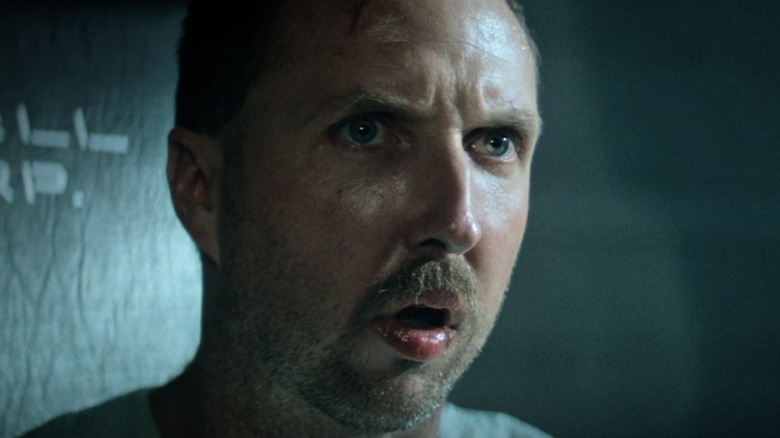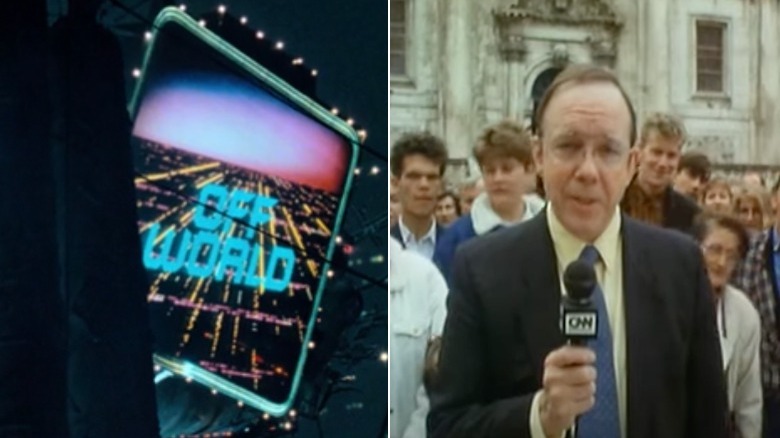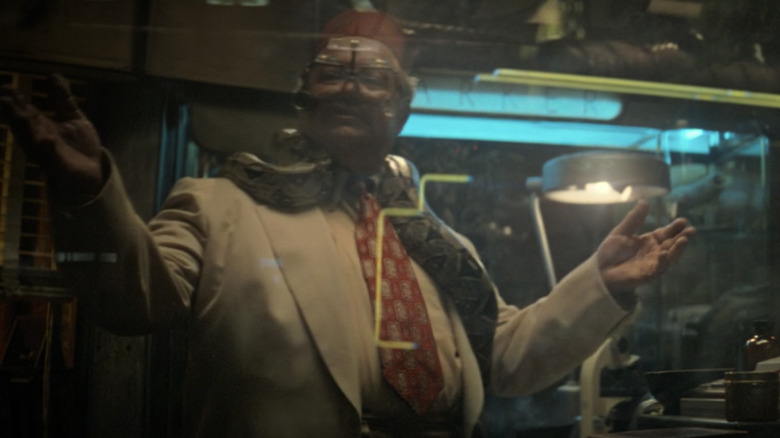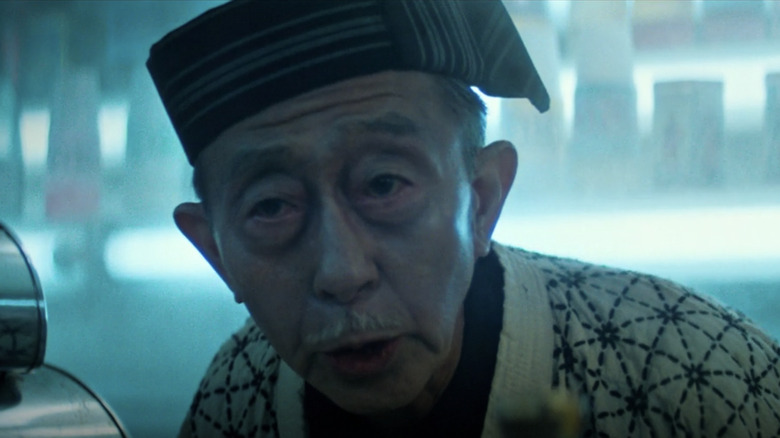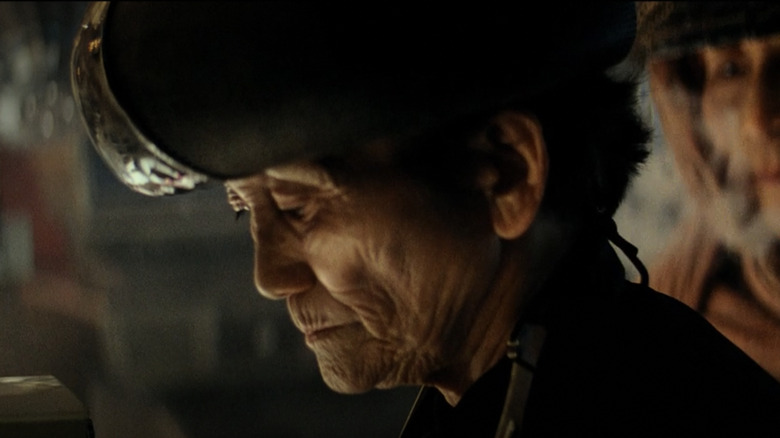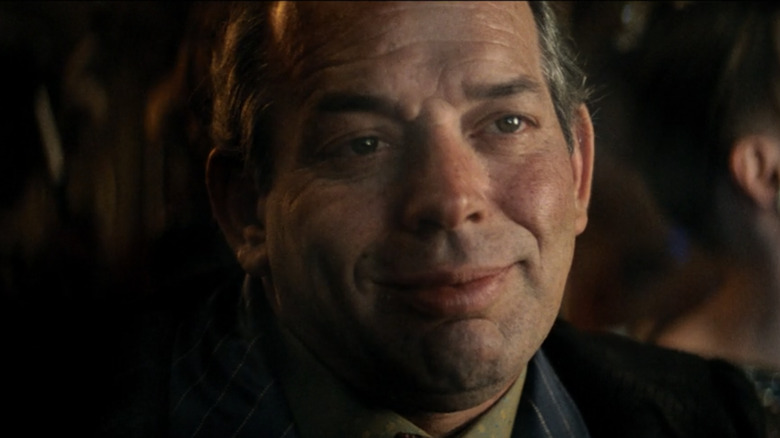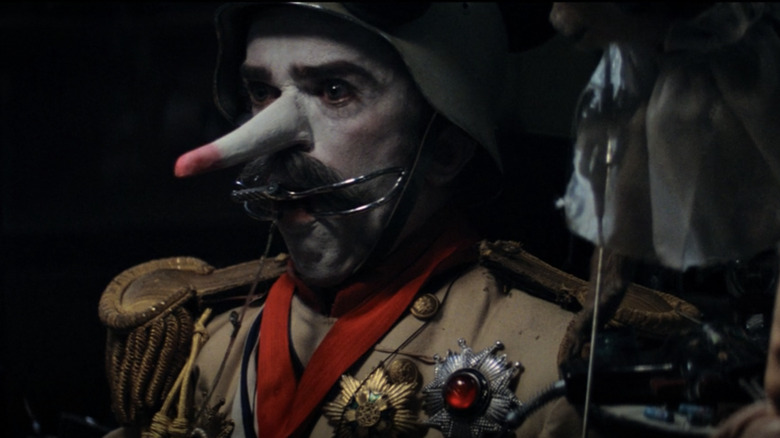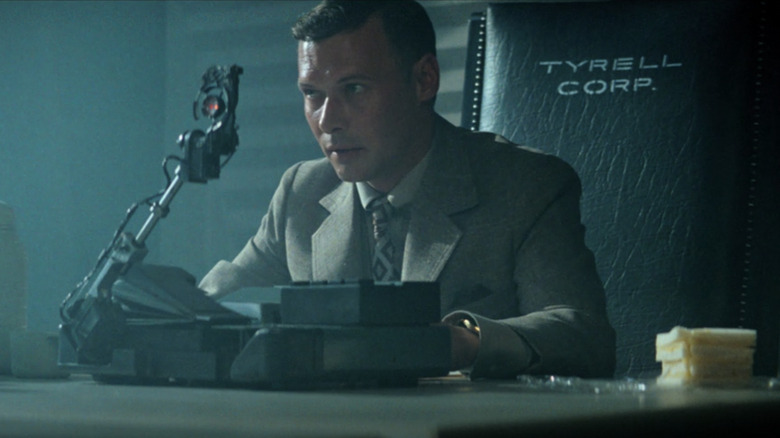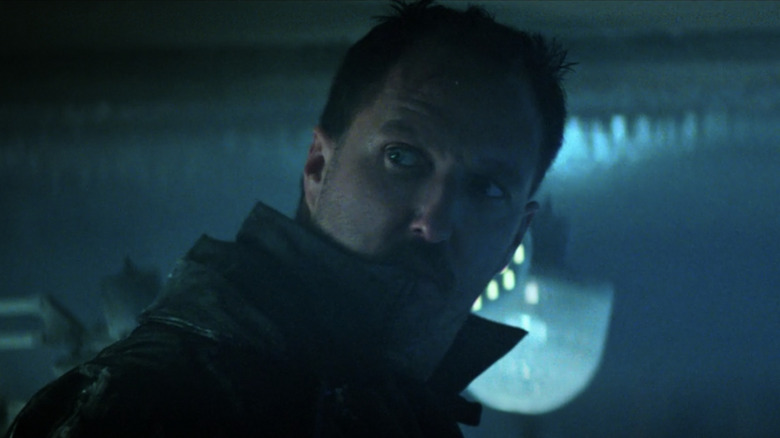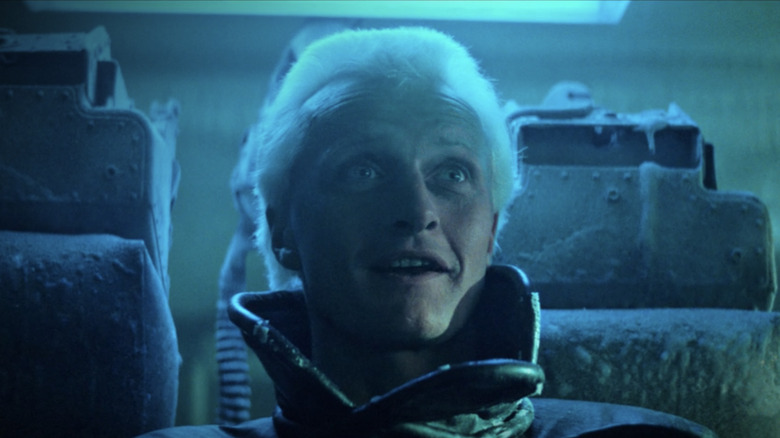The Blade Runner Actors You May Not Know Passed Away
Ridley Scott's visionary sci-fi noir "Blade Runner" was a modest critical and commercial success upon its 1982 release. Most critics echoed Roger Ebert's first impression, that it was visually striking but lacked a human touch, while at the box office it was dwarfed by megahits like "E.T. The Extra Terrestrial" and "Rocky III." Based on the Philip K. Dick novel "Do Androids Dream of Electric Sheep?" (with a title pulled from an unrelated sci-fi script), Scott and his collaborators invented the eternally dark, rain-soaked Los Angeles of 2019, where a former cop (Harrison Ford) is tasked with eliminating a cadre of fugitive humanoid "replicants" who have escaped from the off-planet menial labor they were designed for and found their way to Earth.
In the decades since that initial reception, the film has become a classic of '80s sci-fi, massively influential on not only generations of stylish, noir-inflected films, but video games and anime as well. The release of a 1992 director's cut that removed Ford's clunky voiceover narration and reinstated the film's more ambiguous ending improved its reputation beyond being just a cult classic. Even Ebert was finally won over, reviewing the film a third and final time in 2007 for his Great Movies series. A decades-later sequel, Denis Villeneuve's "Blade Runner 2049" premiered in 2017.
In addition to its peerless style and haunting questions on the nature of existence, "Blade Runner" has a killer cast, including future stars Daryl Hannah and Sean Young and character actor stalwarts like M. Emmet Walsh, Edward James Olmos, and William Sanderson. Many in the cast, however, are no longer with us. Let's take a look at "Blade Runner" actors that you may not realize have since passed away.
Marc Smith
The film begins with a now iconic, panoramic view of 2019 Los Angeles, from the top of the monolithic Tyrell Building all the way down to the food vendors on the dark, wet streets. Above the common people, flying advertisements for the "off-world colonies" offer a fresh start on a new planet. "A golden land of opportunity and adventure!" the narrator touts, in pointed contrast to what we see on the ground.
The narrator of this airborne billboard is voice actor Marc Smith. Born in St. Louis, Smith made his name primarily as an actor in the United Kingdom. His authoritative voice made him a natural for voice work, providing English dubs for Italian roles in the 1982 BBC miniseries "Verdi" and 1985's "Mussolini and I," featuring an international cast that included Anthony Hopkins, Bob Hoskins, and Susan Sarandon. He lent his evening news-ready pipes to a number of comedies over the years as well, playing a CNN reporter in writer-director Peter Richardson's 1991 comedy "The Pope Must Die" (released in the US by Miramax under the title "The Pope Must Diet"), and lampooning Phil Donahue on Richardson's 1995 sketch comedy series "The Glam Metal Detectives." Genre fans likely know Smith best from a small role in the 1981 BBC adaptation of "The Hitchhiker's Guide to the Galaxy" and for providing English dubs on a number of influential 1980s anime series, including "Project A-Ko" and "Dominion Tank Police." Smith died in 2006 at the age of 61.
Ben Astar
Character actor Ben Astar appears a little bit less than halfway through the film as Abdul Ben Hassan, purveyor of replicant snakes whose handiwork — or at least, a scale's worth — is the key to tracking down the fugitive replicants for Rick Deckard (Ford). The scene is part of a larger sequence in which Deckard makes his way through a bazaar of synthetic animals for sale; his shoe-leather detective work in tracking down the maker of the scale makes this one of the film's most explicit nods to old-fashioned private eye movies. Even Astar's costume — a white suit and red fez — wouldn't look out of place in a Humphrey Bogart film (Sydney Greenstreet wore a similar fez in "Casablanca"), or even one of Harrison's own Indiana Jones movies.
Born in 1909, Astar was a fixture in film and television starting in the 1950s. He often played Russian or Middle Eastern characters, as in the Dana Andrews Cold War thriller "Assignment: Paris," "The Marriage-Go-Round" with James Mason and Julie Newmar, and in the first two episodes of the 1966 "Batman" series. Astar had few credits during the 1970s, but returned to acting briefly in the early 1980s, appearing on episodes of "The Magical World of Disney" and the short-lived "Casablanca" spin-off series. Astar died in 1988.
Bob Okazaki
One of the most notable yet unexplained design elements in "Blade Runner" is the heavy east Asian influence on its Los Angeles of the future. Perhaps keying into '80s anxieties over an economically-ascendant Japan, the mean urban streets that Deckard walks are crowded with Asian-style food stalls, open-air markets, and neon signs in multiple languages. Edward James Olmos, playing fellow blade runner Gaff, even speaks in a mishmash of English, French, and Japanese that the actor himself developed, known as "cityspeak." In Gaff's first scene, his cityspeak is translated to Deckard by a food stall operator played by actor Bob Okazaki.
Credited as "Sushi Master," the role is one of many literally no-name parts that Okazaki played over his decades-long career in Hollywood. His resume is littered with roles such as "Gardener" on episodes of "Perry Mason" and "The FBI," "Farmer" on "Love on a Rooftop" and "MASH," and simply "Oriental Man" on an episode of the Bill Bixby detective series "The Magician." While these roles may inadvertently highlight the challenges that Asian actors have long experienced in finding meaningful work as actors, they are not the entire story of Okazaki's career, which included several guest roles on the 1960s series "Hawaiian Eye" and a recurring role on the final season of the "All in the Family" spin-off "Archie Bunker's Place" in 1983. That would be Okazki's final credit; he died in 1985 at age 83.
Kimiko Hiroshige
Hawaiian actress Kimiko Hiroshige makes her brief appearance as "Cambodian Lady" in the same replicant bazaar sequence in which Ben Astar appears. Deckard first brings the mysterious animal scale to her stall, believing it to possibly be a fish scale. The Lady scans it and confirms to Deckard that it is in fact a snake scale, manufactured by Abdul Ben Hassan.
Hiroshige's film career was somewhat brief, and like Bob Okazaki's, was filled with nameless characters — or rather, characters named after their basic description, as in the five episodes of "MASH" she appeared in as "Korean Woman" or the 1985 episode of the "MASH" spin-off "Trapper John, M.D." in which she appeared as "Asian Patient." Her first credited role was as "Aunt Sumi" in the 1976 "Happy Days" episode "Arnold's Wedding," which also featured Pat Morita and Nobu McCarthy. In addition to "Blade Runner," Hiroshige appeared in the small-town satire "Honky Tonk Freeway" in 1981 and the 1987 action movie "Steele Justice." Her final role was in the first episode of the NBC Vietnam drama "China Beach" in 1988; Hiroshige died in 1989.
Hy Pyke
Deckard's search for the replicant snake takes him from Cambodian Lady and Abdul Ben Hassan to a seedy Chinatown bar and burlesque club run by Taffey Lewis, a sleazy little character played by actor Hy Pyke. Lewis is less than helpful, but Deckard soon finds the snake and its owner, exotic dancer Zhora (Joanna Cassidy). Zhora quickly reveals herself as one of Roy Batty's (Rutger Hauer) fellow escaped replicants, as she nearly murders Deckard and takes off into the street.
"Blade Runner" is something of an outlier in Pyke's career, which was mostly spent in bottom-of-the-barrel B-movies such as "Spawn of the Slithis," the blaxploitation classic "Dolemite," and a soft-core erotic musical adaptation of "Don Quixote." Born Monty Pike into a family of vaudeville comedians, he found a home in the independent film scene of the 1970s, where high art, low art, comedy, and camp all mixed together — "at a time when wacky was hip," as author Foster Dickson wrote in a 2021 appreciation. Pyke died in 2006; his final film was a posthumous appearance in the 2012 indie comedy "Dealing."
John Edward Allen
Replicant Pris (Daryl Hannah) is taken in by J.F. Sebastian (William Sanderson), a Tyrell Corporation genetic engineer whose house is a disturbing collection of robotic puppets at varying degrees of sentience. Among his menagerie is Kaiser, a kind of living toy soldier played by British actor John Edward Allen who, along with a walking teddy bear (Kevin Thompson), greets Sebastian when he comes home with a "Home again, home again, jiggity jig!"
Born with dwarfism, Allen left his hometown of Southampton in the early 1970s to fulfill his dream of becoming an actor. Roles on stage and in films such as "The Eyes of Laura Mars" and "Under the Rainbow" followed, but other than "Blade Runner" Allen is likely best known for being Ozzy Osbourne's "personal dwarf" on the rock singer's first solo tour after being kicked out of Black Sabbath. Allen was hired to accompany Ozzy, serving drinks during shows, and even performed a stunt where it appeared as if he was hanged on stage. Offstage, Allen and Osbourne were kindred spirits in overconsumption, indulging in drugs and alcohol. In the early 1990s Allen returned to his native Southampton; his last film role was in 1997's "Snow White: A Tale of Terror." He died from an overdose in 1999.
If you or anyone you know is struggling with addiction issues, help is available. Visit the Substance Abuse and Mental Health Services Administration website or contact SAMHSA's National Helpline at 1-800-662-HELP (4357).
Morgan Paull
Longtime character actor Morgan Paull plays Holden, the blade runner who becomes the film's first casualty as he is administering tests on new Tyrell Corporation employees to see if any of them are replicants. The test, referred to as the Voight-Kampff test, is a series of odd questions designed to provoke an emotional response. Holden gets more of a response than he bargained for while testing Leon Kowalski (Brion James), one of the escaped replicants, who sends Holden flying through the office wall via a blast from his high-powered futuristic pistol.
Born in West Virginia, Paull caught the acting bug in high school. After a few years acting on stage in Virginia and on Broadway, Paull headed to the West Coast. Roles in "Patton" and "Norma Rae" followed, along with numerous television appearances on "The FBI," "Ironside," and "Gunsmoke." Originally, he was hired by "Blade Runner" director Ridley Scott simply to assist with auditions, but soon found himself given an on-camera role; "Halfway through the tests, Ridley fell in love with me," he joked to The Hollywood Reporter in 2012, shortly before his death.
Off-camera, Paull was well known in Hollywood for his work with the Screen Actors Guild and for his conservative politics, as well as for mostly leaving acting behind starting in the 1980s to become a talent agent. He died of stomach cancer in 2012.
Brion James
Along with Morgan Paull, hulking character actor Brion James is our introduction to the world of replicants and blade runners. As Leon Kowalski, James shows not only what these fugitive replicants are willing to do to evade capture, but also why the invasive Voight-Kampff test is needed. All the film's other known replicants, including Sean Young as Tyrell Corporation assistant Rachael, have an otherworldly look and/or an eerie affect to their performance. James was certainly a striking actor at six-feet-three-inches tall, but he lives comfortably on camera.
The California native, who studied acting in New York, got his start on camera in the mid-1970s playing guards, henchmen, and other heavies on "Get Christie Love," "Roots," and in films like "Corvette Summer" and "Wholly Moses!" As an actor, James was not choosy about his roles, and his resume is littered with low-budget thrillers, direct-to-video sci-fi flicks, and other disreputable genres. But he also was a frequent collaborator with director Walter Hill, and appeared in films by Hal Ashby, Peter Bogdanovich, and Robert Altman. James lent his voice talents to 1990s animated series including "Superman," "Spawn," and "Aaahh!!! Real Monsters"; in 1997 he reprised the role of Leon for a video game adaptation of "Blade Runner." He died after suffering a heart attack in 1999.
Rutger Hauer
The tragedy of the replicants is the curse of all intelligent beings, which is the understanding that life is finite, but to yearn for more of it nonetheless. Replicants are designed to only live for four years; when Roy Batty and his collaborators escape from their off-world labor, they come to Earth not to conquer or even get revenge (though that ends up being part of it), but to find a way to keep living. Batty, played memorably by Dutch actor Rutger Hauer, understands what is lost when a life ends — and in the film's climax laments that his memories will be forever gone, giving one of the all-time great cinematic death speeches:
"I've seen things you people wouldn't believe. Attack ships on fire off the shoulder of Orion. I watched C-beams glitter in the dark near the Tannhäuser Gate. All those moments will be lost in time, like... tears in rain. Time to die."
While "Blade Runner" was Hauer's official introduction to American audiences, he had been a star in his native Netherlands for over a decade, collaborating with director Paul Verhoeven on bold, provocative films like "Turkish Delight" and "Soldier of Orange." In Hollywood, his shock of platinum hair and ice-blue eyes marked him early as a villain in horror films like "The Hitcher" and the original "Buffy the Vampire Slayer," though he was also able to flex his hero muscles in the 1985 medieval fantasy "Ladyhawke" and the action flick "Blind Fury." In 1988, Hauer won acclaim for the Italian drama "The Legend of the Holy Drinker," but remained a genre film stalwart the rest of his life, rarely appearing in the kinds of films that court awards recognition. The 21st century saw him in "Batman Begins," "Sin City," and playing TV vampires on both "Salem's Lot" and "True Blood." He died in July 2019 at age 75.
